Have you ever wondered where the Philippines is located? Is it hidden among the vast expanse of Southeast Asia, or does it hold a prominent position on the world map? Unravel the mystery of the Philippine archipelago and explore its unique location.
Located in Southeast Asia, the Philippines is an enchanting archipelago that stretches across the South China Sea and the Pacific Ocean. With over 7,000 islands and islets, this island nation is a hidden gem waiting to be discovered.
The Philippines is situated approximately 500 miles off the coast of Vietnam. It is bordered by the Philippine Sea to the east, the Celebes Sea to the south, and the South China Sea to the west and north. This strategic location places the Philippines at the crossroads of diverse cultures and trade routes.
Manila, the bustling capital, is nestled within the archipelago, while Quezon City stands as the most populous city in the Philippines. From breathtaking beaches to stunning landscapes, the Philippines is a tropical paradise that captivates the hearts of both locals and visitors.
Key Takeaways:
- The Philippines is located in Southeast Asia, between the South China Sea and the Pacific Ocean.
- It is comprised of over 7,000 islands and islets, with Luzon and Mindanao being the largest.
- The country is approximately 500 miles off the coast of Vietnam.
- The Philippines is situated between the Philippine Sea, Celebes Sea, and the South China Sea.
- Manila is the capital, while Quezon City is the most populous city.
The Geography of the Philippines
The Philippines is a unique and diverse archipelago that boasts a fascinating geography. With over 7,641 islands, the country is spread out in a triangular shape, with Luzon, the largest island, located in the north, and Mindanao in the southeast. The archipelago stretches approximately 1,150 miles from north to south and covers a wide east-west extent.
The topography of the Philippines is characterized by a variety of landforms. The terrain features majestic mountain ranges, sprawling coastal plains, and captivating lakes. The major islands in the Philippines are Luzon, Visayas, and Mindanao.
The following table provides a brief overview of the major islands in the Philippines:
| Island | Location | Features |
|---|---|---|
| Luzon | Northern Philippines | – Home to the capital city of Manila – Mount Pinatubo, an active volcano – Banaue Rice Terraces, a UNESCO World Heritage Site |
| Visayas | Central Philippines | – Famous for stunning beaches like Boracay and Cebu – Historical sites such as Magellan’s Cross in Cebu City |
| Mindanao | Southern Philippines | – Abundant natural resources – Mount Apo, the highest peak in the Philippines – Home to diverse indigenous cultures |
With its diverse geography and breathtaking landscapes, the Philippines offers a wide range of experiences for adventurers, nature enthusiasts, and beach lovers. Whether you’re exploring the stunning rice terraces in Luzon or diving into the crystal-clear waters of Visayas, the Philippines is sure to captivate your senses.
“The Philippines is an archipelago made up of thousands of islands, each with its own unique charm and beauty. From the towering peaks of Luzon to the pristine beaches of Visayas and the cultural richness of Mindanao, there’s something for everyone in this tropical paradise.”
Philippine Landforms and Geographic Features
The Philippines is a country renowned for its diverse landforms and striking geographic features. From majestic mountain ranges to breathtaking coastlines, this archipelago offers a wealth of natural wonders for visitors and locals alike.
Mountain Ranges
Spanning different regions of the Philippines, several mountain ranges dominate its topography. Notable among them are:
| Mountain Range | Location |
|---|---|
| Cordillera Central | Luzon |
| Sierra Madre | Along the Pacific coast |
| Diuata Mountains | Mindanao |
Coastlines
The Philippine archipelago is blessed with extensive coastlines, stretching approximately 22,550 miles in total. These coastlines offer picturesque views, pristine beaches, and diverse marine ecosystems.
Notable Geographic Features
The Philippines is also home to various notable geographic features that captivate the imagination. Some of these include:
- Lake Sultan Alonto: Located in Lanao del Sur, this majestic lake delights visitors with its serene beauty and unique biodiversity.
- Mount Apo: Rising 9,692 feet above sea level, Mount Apo is the highest peak in the Philippines and a favorite destination for adventurous mountain climbers.
- Puerto Princesa Subterranean River National Park: This UNESCO World Heritage Site is renowned for its underground river system, offering awe-inspiring limestone formations and a glimpse into the Philippines’ natural wonders.
Coordinates
The coordinates of the Philippines are approximately 13°N latitude and 122°E longitude, placing the archipelago in a strategic location within Southeast Asia.
Immerse yourself in the beauty of the Philippine landforms and geographic features, and discover the awe-inspiring wonders that await in this tropical paradise.
Historical and Cultural Influences on the Philippines
The Philippines boasts a diverse history that has been shaped by various influences, leaving a significant impact on its culture, language, and religion. One of the most profound periods in Philippine history was the era of Spanish colonization, which lasted for over 300 years. This period, from the 16th century until the late 19th century, brought about a fusion of indigenous Filipino customs and practices with Spanish traditions.
During Spanish colonization, the Spanish introduced their language, religion, and legal system to the indigenous population. The Spanish language became integral to Filipino culture, and today, English and Filipino (based on the Tagalog language) are the official languages of the Philippines. Additionally, Roman Catholicism became the dominant religion in the country, and its influence can still be seen in the numerous churches and religious festivals celebrated throughout the archipelago.
However, Spanish colonization was not the only significant period in Philippine history. The Philippines also came under U.S. control following the Spanish-American War in the late 19th century. This era, which lasted for 48 years, had a tremendous impact on the country’s political, educational, and cultural systems. The educational system was heavily influenced by the American model, with English being widely taught and spoken. The Philippines also adopted a democratic system of government, aligning itself more closely with Western ideals.
“The fusion of Spanish and Filipino cultures has resulted in a unique and vibrant cultural identity that sets the Philippines apart.”
Today, the Philippines is the second most populous Asian country, with a rich and diverse cultural heritage. Filipino culture reflects a blend of Asian and Western influences, with a strong emphasis on family values, hospitality, and respect for elders. Music and dance play a central role in Filipino culture, with traditional forms such as the tinikling and the singkil showcasing the country’s artistic prowess.
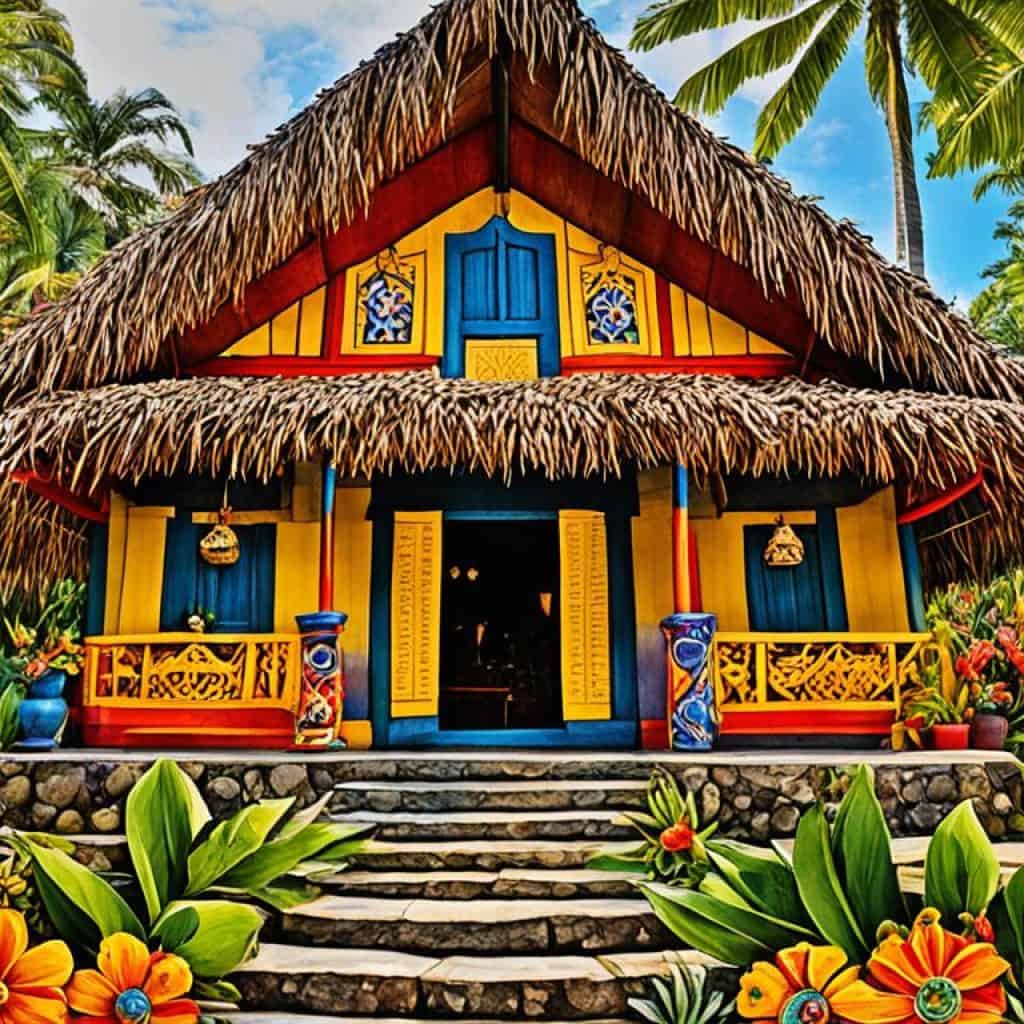
Philippine History: A Tapestry of Traditions
The history of the Philippines is a tapestry of traditions, shaped by centuries of colonization, revolution, and cultural exchange. The Filipino people have demonstrated resilience and a deep sense of national identity, as seen in the People Power movement of 1986. This revolution led to the peaceful overthrow of an oppressive regime and the restoration of democratic government.
While the Philippines has faced its fair share of political challenges, its rich history and vibrant cultural heritage continue to resonate with its people. The fusion of Spanish, American, and indigenous influences has resulted in a unique and dynamic cultural identity that sets the Philippines apart. Filipino culture is a testament to the resilience, creativity, and warmth of the Filipino people.
| Key Influences | Impact on Filipino Culture |
|---|---|
| Spanish Colonization | Introduction of Christianity, Spanish language, and fusion of Spanish and indigenous traditions. |
| American Influence | Adoption of English as an official language, democratic governance, and education system reform. |
Through the lens of its historical and cultural influences, it becomes evident that the Philippines is a melting pot of traditions, reflecting its unique position as a bridge between East and West. The Filipino people continue to celebrate their heritage, preserving their customs while embracing the influences that have shaped their society.
Economic and Environmental Challenges in the Philippines
The Philippines, with its vast resources, faces both economic and environmental challenges. While the country has the potential for a strong industrial economy, it remains predominantly agricultural. This reliance on agriculture limits the overall economic growth and development.
Rapid industrial expansion during the late 20th century has also resulted in significant environmental degradation. The unchecked growth of industries, especially in urban areas, has led to pollution, deforestation, and the destruction of natural habitats. These activities have had a detrimental impact on the country’s natural resources and biodiversity.
Furthermore, the Philippines is prone to natural disasters such as typhoons and earthquakes. These events disrupt economic activities, causing damage to infrastructure, agriculture, and the overall livelihoods of the people. The country has had to invest heavily in disaster preparedness and response to mitigate the impact of these disasters.
However, amidst these challenges, the Philippines has emerged as a regional leader in education. The country boasts one of the highest literacy rates in Asia and has made significant strides in improving access to quality education. This focus on education has allowed the Philippines to develop a skilled and knowledgeable workforce, contributing to its economic growth and resilience.
Philippine Economy
The Philippine economy relies on a diverse range of industries, including agriculture, light industry, and services. While agriculture plays a significant role in the country’s economy, there has been a shift towards the service sector in recent years, particularly in areas like tourism and outsourcing.
Here is a table highlighting the contribution of different sectors to the Philippine economy:
| Sector | Contribution |
|---|---|
| Agriculture | XX% |
| Industry | XX% |
| Services | XX% |
Table: Contribution of sectors to the Philippine economy.
As depicted in the table above, agriculture still plays a significant role in the economy, although the service sector is growing in importance. This diversification of industries has helped the Philippines withstand economic fluctuations and adapt to changing global trends.
The Philippine government recognizes the need for sustainable development and has implemented various policies and initiatives to address environmental challenges. Efforts include promoting renewable energy sources, protecting biodiversity hotspots, and strengthening environmental regulations.
While the Philippines continues to face economic and environmental challenges, the country’s resilience and commitment to sustainable development provide hope for a brighter future.
The Philippine People and Culture
The Filipino people are a vibrant and diverse community with a rich cultural heritage. They are primarily of Malay descent, with influences from Chinese, American, and Spanish ancestry. This diverse ethnic background has contributed to the unique Filipino culture, which is a beautiful amalgamation of indigenous traditions, Asian customs, and Western influences.
Filipinos are known for their warm hospitality and strong family ties. Family is an essential part of Filipino culture, and people prioritize spending time with their loved ones. In Filipino society, respect for elders is highly valued, and the concept of “pakikisama” promotes harmonious relationships and a sense of community among individuals.
Music and dance are integral to Filipino culture, with various traditional forms and styles. The Tinikling, a popular folk dance, involves rhythmic footwork between two sets of bamboo poles. Traditional music often incorporates instruments like the guitar, kulintang (a set of gongs), and the bamboo flute.
The Philippines is renowned for its vibrant festivals and colorful celebrations throughout the year. One of the most famous festivals is the Ati-Atihan, held in Kalibo, Aklan. It honors the Santo Niño, and participants paint their faces with black soot and wear traditional Aklanon attire. Another renowned festival is the Sinulog in Cebu, which commemorates the Filipino people’s conversion to Christianity.
Arts and crafts are an integral part of Filipino culture, showcasing the creativity and craftsmanship of the people. Traditional weaving, pottery-making, and basket weaving are among the skills passed down through generations. These crafts reflect the deep connection Filipinos have with their natural surroundings and their ancestral roots.
| Festivals | Location | Description |
|---|---|---|
| Ati-Atihan | Kalibo, Aklan | A lively festival honoring the Santo Niño, characterized by vibrant costumes, traditional music, and street dancing. |
| Sinulog | Cebu City, Cebu | A grand celebration featuring a series of religious and cultural events, including a street procession and dance competition. |
| Pahiyas | Lucban, Quezon | A harvest festival where houses are adorned with colorful rice decorations as a way to give thanks for a bountiful harvest. |
The Filipino people are proud of their cultural heritage and strive to preserve and promote their traditions. With their warmth, hospitality, and resilience, they continue to shape the vibrant and diverse tapestry of Filipino culture.
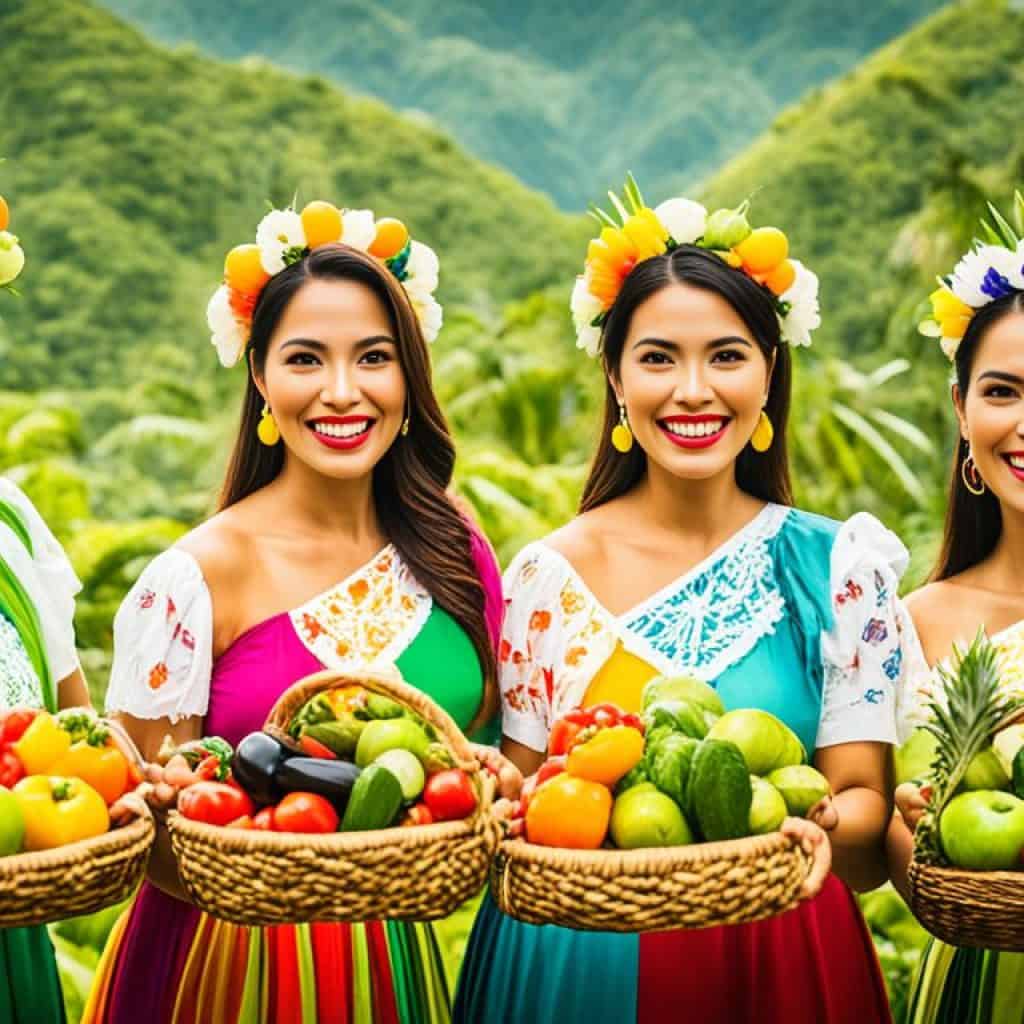
Political and Governmental Structure in the Philippines
The Government of the Philippines operates under a unitary presidential constitutional republic. This means that the President serves as both the head of state and government and is elected by the Filipino people. The country’s political system is characterized by a strong executive branch with a centralized authority.
The legislative branch of the Philippine government is composed of a bicameral assembly, with the Senate and the House of Representatives. The Senate is comprised of 24 members, who are elected nationwide, while the House of Representatives consists of 304 members, who are elected through local districts. The legislative branch is responsible for creating and passing laws that govern the country.
The judicial branch is headed by the Chief Justice and includes the Supreme Court, which is responsible for interpreting and applying the law. The judiciary plays a crucial role in upholding the rule of law and ensuring justice for all.
“The government of the Philippines is built on a strong foundation of democratic principles and institutions, designed to protect the rights and liberties of its citizens.”
Important Positions in the Philippine Government
There are several important positions within the Philippine government that play key roles in its functioning.
- The President: As the head of state and government, the President has executive powers and is responsible for leading the country.
- The Vice President: The Vice President supports the President and assumes the duties of the office in case of absence or incapacity.
- The Senate President: The Senate President leads the Senate and sets the legislative agenda in collaboration with the House Speaker.
- The House Speaker: The House Speaker presides over the sessions of the House of Representatives and ensures its smooth operation.
- The Chief Justice: The Chief Justice heads the Supreme Court and is responsible for the administration of justice in the country.
These positions are vital in maintaining the checks and balances of power within the Philippine government, ensuring transparency, accountability, and the protection of the rights and welfare of the Filipino people.
Government Structure in the Philippines
The political and governmental structure in the Philippines can be summarized in the following table:
| Branch | Position | Responsibilities |
|---|---|---|
| Executive | President | Serves as the head of state and government, exercises executive powers. |
| Legislative | Senate | Passes laws, represents the interests of the Filipino people. |
| Legislative | House of Representatives | Passes laws, represents the interests of local districts. |
| Judicial | Supreme Court | Interprets and applies the law, ensures justice for all. |
The Government of the Philippines is structured in a way that promotes democratic governance and the welfare of its citizens. It operates through a system of checks and balances, allowing for transparency, accountability, and the protection of key constitutional rights.
Education System in the Philippines
The education system in the Philippines plays a crucial role in shaping the future of Filipino students. With a compulsory education starting at the age of seven, the country is committed to providing access to quality education for all its citizens. The education system is structured into two main levels: elementary and secondary education.
Elementary Education:
The elementary education program in the Philippines spans six years, allowing students to develop a strong foundation of knowledge and skills. This stage focuses on building essential competencies in various subjects, such as English, Mathematics, Science, and Filipino.
Secondary Education:
After completing elementary education, Filipino students move on to four years of secondary education. This level aims to deepen their learning and prepare them for higher education or entry into the workforce. Students have the option to choose between academic or technical-vocational tracks based on their interests and career aspirations.
In addition to the public school system, the Philippines also has a well-established private school sector that offers diverse educational programs. Higher education institutions, including universities and colleges, provide opportunities for further specialization and professional development.
Educational Achievements: Filipino Literacy Rates
The Philippines takes pride in its high literacy rates, which reflect the nation’s commitment to education. According to the United Nations Educational, Scientific and Cultural Organization (UNESCO), the literacy rate for Filipinos aged 15 years and above is approximately 97.95%.
“Education is the key to unlocking opportunities and empowering individuals to reach their full potential. In the Philippines, we strive to ensure that every Filipino has access to quality education and the necessary skills to thrive in an ever-evolving world.”
English is taught as a second language in schools, enabling Filipinos to communicate effectively in a global context. The proficiency in English has also positioned the Philippines as a prominent outsourcing destination, attracting international companies seeking skilled professionals.
The Philippine education system continually evolves to adapt to the changing needs of learners and the demands of the modern world. Efforts are being made to enhance the curriculum, promote critical thinking, and foster creativity among students. The government, educators, and stakeholders collaborate to provide inclusive and quality education that empowers individuals and contributes to the nation’s progress.
| Educational Level | Literacy Rate |
|---|---|
| Elementary Education | 98.37% |
| Secondary Education | 96.46% |
| Tertiary Education | 96.32% |
Philippine Economy and Industries
The Philippine economy thrives on a diverse range of industries, with agriculture, light industry, and services being the key contributors. The country’s rich natural resources and favorable climate make agricultural production a significant part of the economy.
Philippine agriculture produces a wide variety of products, including bananas, rice, coconuts, corn, and fish. These agricultural exports contribute to both domestic consumption and international trade, strengthening the country’s position in the global market.
The mining industry plays an important role in the Philippine economy as well. The country is known for its mineral-rich lands, particularly in gold and copper reserves. Mining activities generate employment opportunities and contribute to the national revenue.
The service sector has experienced remarkable growth in recent years, fueled by tourism and business process outsourcing (BPO) industries. The Philippines has become a popular destination for international tourists, attracted by its pristine beaches, vibrant cities, and rich cultural heritage. Additionally, the BPO industry has flourished, providing a range of services such as customer support, IT outsourcing, and back-office operations, contributing to job creation and economic stability.
“The Philippines has immense potential in its agriculture, mining, and service sectors. These industries drive economic growth, create employment opportunities, and contribute to the overall development of the country.”
Agricultural Products of the Philippines:
| Product | Quantity Produced | Main Regions |
|---|---|---|
| Bananas | 5.2 million metric tons | Davao Region, Northern Mindanao |
| Rice | 19.4 million metric tons | Cagayan Valley, Central Luzon |
| Coconuts | 15.3 billion nuts | Calabarzon, Bicol Region |
| Corn | 8.2 million metric tons | Cagayan Valley, Central Luzon |
| Fish | 4.6 million metric tons | Pangasinan, Western Visayas |
The Philippines has capitalized on its agricultural advantages to contribute to the nation’s economic growth. The abundance of natural resources, combined with the country’s entrepreneurial spirit, positions the Philippines as a vibrant player in the global economy.
Historical and Cultural Landmarks in the Philippines
The Philippines is a treasure trove of historical and cultural landmarks that showcase its rich heritage. From ancient ruins to stunning architectural wonders, this Southeast Asian nation offers a plethora of attractions for tourists. Here are some notable landmarks that should be on every traveler’s itinerary:
The walled city of Intramuros
The walled city of Intramuros, located in Manila, is a living testament to the country’s Spanish colonial past. This historical site is home to well-preserved Spanish colonial architecture, including Fort Santiago, Plaza de Roma, and San Agustin Church. Visitors can take a leisurely stroll along the cobblestone streets, explore centuries-old churches, and immerse themselves in the rich history of the Philippines.
The Ifugao Rice Terraces
Nestled in the province of Ifugao, the Ifugao Rice Terraces are a marvel of human ingenuity and a UNESCO World Heritage Site. These ancient terraces are carved into the mountainside and have supported agricultural practices for over 2,000 years. Visitors can hike through the terraces, learn about traditional farming techniques, and witness the breathtaking beauty of this cultural landmark.
The Chocolate Hills
Located in the province of Bohol, the Chocolate Hills are an otherworldly natural wonder. These iconic hills are composed of perfectly shaped mounds that turn brown during the dry season, resembling giant chocolate drops. Visitors can climb to the top of the hills and enjoy panoramic views of the surrounding countryside.
Beaches of Boracay and Palawan
The Philippines is renowned for its pristine white-sand beaches, and two of the most famous destinations are Boracay and Palawan. Boracay offers powdery white sands, crystal-clear turquoise waters, and vibrant nightlife, making it a paradise for beach lovers and partygoers alike. Palawan, on the other hand, is a tropical paradise boasting picturesque islands, stunning limestone cliffs, and world-class diving spots like the Tubbataha Reefs Natural Park.
These are just a few examples of the many historical and cultural landmarks that await visitors in the Philippines. Whether you’re exploring ancient ruins, marveling at architectural wonders, or basking in the sun on pristine beaches, the Philippines offers a wealth of attractions that cater to every traveler’s interests.
Philippine Biodiversity and Wildlife
The Philippines is renowned for its remarkable biodiversity and rich wildlife. With over 7,000 islands, the country is home to a diverse range of species, including unique and endangered ones.
One of the most iconic creatures found in the Philippine wildlife is the Philippine eagle. Also known as the “monkey-eating eagle,” it is one of the largest and most powerful eagles in the world. This critically endangered species resides primarily in the forests of Luzon, Mindanao, and Samar.
Another remarkable species, the tamaraw, is a dwarf buffalo that is native to the island of Mindoro. It is considered one of the rarest large mammals in the world, with only a few hundred individuals remaining in the wild.
Philippine forests are also home to a vast array of bird species, with over 650 recorded species. Some notable examples include the colorful peacocks, the graceful pheasants, and the majestic hornbills. These avian species contribute to the country’s vibrant ecosystem.
Unfortunately, the Philippine wildlife faces numerous challenges due to deforestation and habitat loss. Many species are now critically endangered or at risk of extinction. It is crucial to raise awareness and take action to protect and conserve these invaluable treasures of nature.
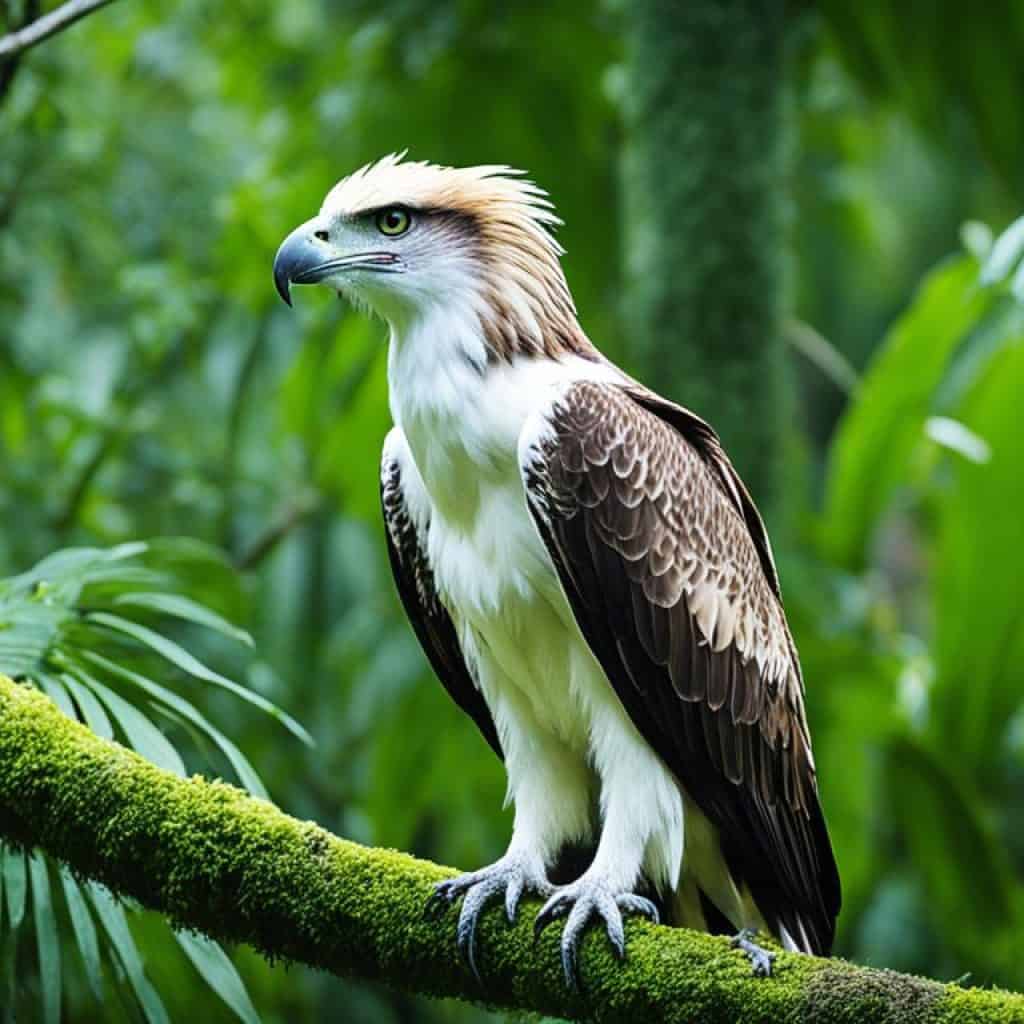
Endangered Species in the Philippines
| Species | Status |
|---|---|
| Philippine Eagle | Critically endangered |
| Tamaraw | Critically endangered |
| Turtle Islands | Endangered |
| Tamaraw | Critically endangered |
| Rafflesia | Critically endangered |
Philippine Political History
The Philippines has a complex political history. It was initially colonized by Spain in the 16th century, marking the beginning of centuries of Spanish influence on the country’s culture, language, and religion. Spanish colonization lasted until the Spanish-American War in 1898, when the United States took control of the Philippines.
Under U.S. rule, the Philippines experienced a period of transition and modernization. The country was granted autonomy in 1935 and subsequently suffered from Japanese occupation during World War II. However, the Philippines achieved full independence on July 4, 1946, marking a significant milestone in its political history.
Throughout the 20th century, the Philippines faced political challenges, including periods of authoritarian rule. One notable period was the declaration of martial law by President Ferdinand Marcos in 1972. This period was marked by widespread human rights abuses and corruption.
“I have faith in the Filipino. I believe in the Filipino. And I am convinced that the Filipino can resurrect himself and find his place in this land.” – President Ferdinand Marcos
However, the resilience and determination of the Filipino people prevailed, leading to the People Power movement in 1986. This peaceful revolution, fueled by popular protests and support, resulted in the ousting of Marcos and the restoration of democratic government led by President Corazon Aquino. The People Power movement serves as a testament to the Filipino people’s unwavering commitment to freedom and democracy.
Since then, the Philippines has continued its journey as a democratic nation, electing its leaders through regular elections and aspiring to uphold the principles of freedom, justice, and equality.
Key Events in Philippine Political History
| Year | Event |
|---|---|
| 1521 | Arrival of Ferdinand Magellan and the beginning of Spanish colonization |
| 1898 | End of Spanish rule, Philippines comes under U.S. control after the Spanish-American War |
| 1935 | Philippine Commonwealth established, granting the country limited self-rule |
| 1942-1945 | Japanese occupation during World War II |
| 1946 | Full independence attained on July 4 |
| 1972 | Declaration of martial law by President Ferdinand Marcos |
| 1986 | People Power Revolution leads to the peaceful ousting of President Ferdinand Marcos |
Conclusion
The Philippines, a vibrant archipelago located in Southeast Asia, mesmerizes visitors with its breathtaking natural beauty, rich cultural heritage, and complex history. This diverse nation is renowned for its stunning landscapes and warm hospitality, making it a must-visit destination for travelers around the world.
Despite being endowed with abundant natural resources, the Philippines grapples with economic and environmental challenges. However, the indomitable spirit of the Filipino people shines through as they navigate these obstacles and continue to celebrate their unique heritage.
From the pristine beaches of Boracay and Palawan to the majestic rice terraces in Luzon and the historic walled city of Intramuros in Manila, the Philippines offers a treasure trove of landmarks and attractions that showcase its rich history and cultural diversity. This Philippine archipelago is home to an array of stunning geographical features, including mountain ranges, coastlines, and lakes, creating unparalleled landscapes.
Whether exploring the vibrant festivals, diving into the colorful underwater world, or immersing oneself in the warm embrace of Filipino hospitality, the Philippines captivates visitors with its beauty, charm, and unique experiences. With its ideal location and rich tapestry of culture and geography, the Philippines truly stands as a remarkable destination, beckoning travelers to discover its wonders.
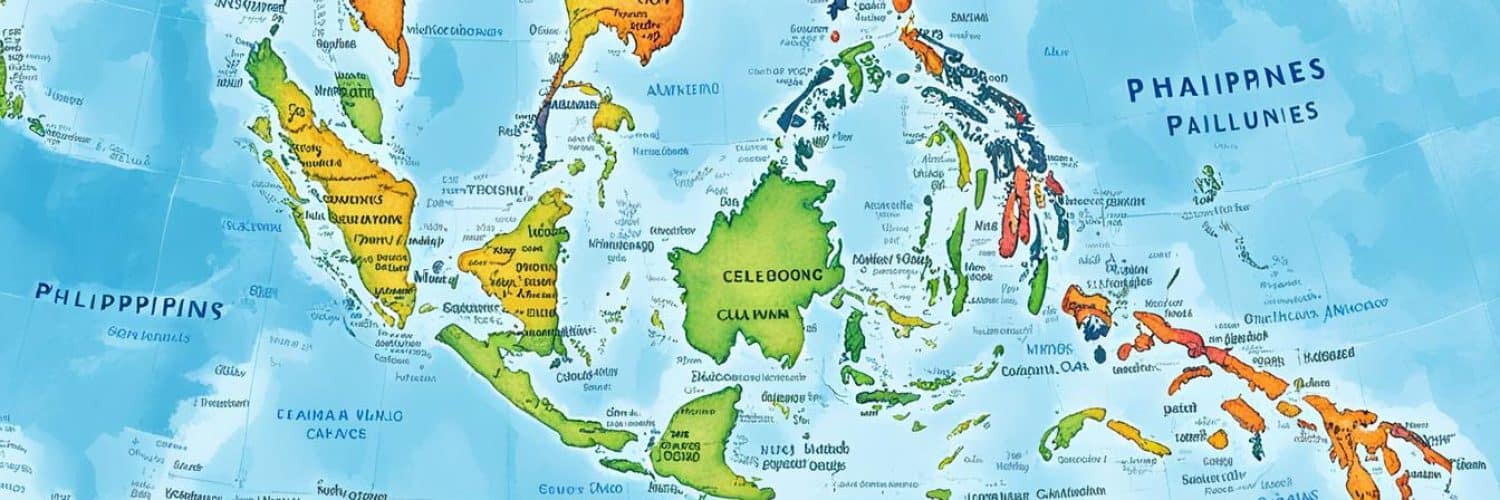
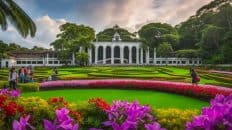
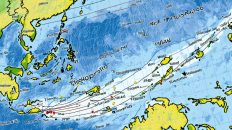
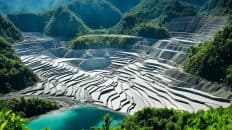










Add comment